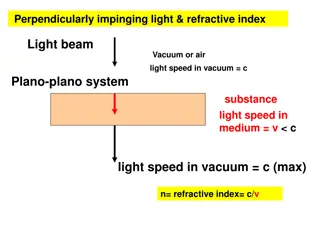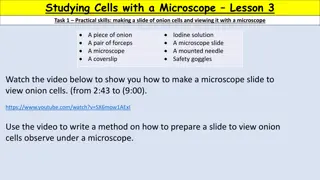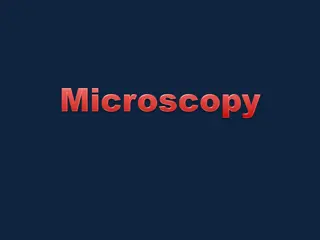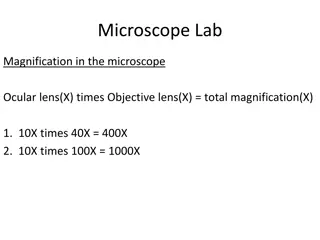Tools for Better Remote Teaching and Learning with ZoomIt
Enhance your remote teaching with ZoomIt, a Microsoft-based screen zoom and annotation tool. Easily zoom in/out, annotate, markup, draw on screen, and capture notes in real-time. Access various options, set hotkeys, adjust zoom magnification, and utilize drawing modes efficiently to engage students
0 views • 5 slides
Visualizing Real Numbers on a Number Line by Successive Magnification
Visualization techniques for representing real numbers on a number line through successive magnification are demonstrated step by step. The procedure involves dividing the line into equal parts and zooming in on specific ranges to accurately locate decimal values. This method helps in understanding
0 views • 12 slides
Visualizing Real Numbers on a Number Line
The procedure of representing real numbers on a number line through successive magnification is explained in detail. It involves dividing the line, marking points, and magnifying specific intervals to accurately position numbers like 5.2316. Each real number corresponds to a unique point on the numb
0 views • 12 slides
Insights on Computational Complexity Threshold Results
Exploring the challenges in proving major lower bounds for computational complexity, focusing on the Hardness Magnification and Minimum Circuit Size Problem (MCSP). Discusses the difficulties in proving weak and strong LBs, highlighting recent theorems and barriers that impact progress in the field.
0 views • 21 slides
Mastering Microscope Focusing Techniques
Understand the essential parts of a light microscope, the magnification process, general procedures for handling a microscope, focusing techniques for specimens, and the relationship between magnification and field of view. Learn how to avoid damaging the microscope and achieve optimal results durin
0 views • 18 slides
Understanding Optics and Magnification in Physics
Today's lecture covers a brief review of optical instruments, Huygens principle, refraction phenomena, and Young's double slit experiment. The session delves into magnifying glasses, magnification power definition, astronomical telescopes, and simple and compound microscopes. Key concepts include th
7 views • 20 slides
Magnifying Christ Through Life and Death
The importance of magnifying Christ in both life and death is emphasized through verses from Philippians 1:20, highlighting the joy found in Christ and the proclamation of salvation and deliverance. The concept of boasting in the cross and being dead to the world but alive in Christ is explored, enc
0 views • 13 slides
Understanding The Light Microscope: A Comprehensive Guide
Delve into the world of microscopy with Dr. Mohammed Hussein's Lab Manual No. 1, covering the fundamentals of the light microscope, its components, lenses, magnification power, resolving power, and detailed instructions on how to focus your microscope effectively for optimal results. Explore the his
0 views • 19 slides
Understanding the Proper Use and Care of a Compound Microscope
Explore the proper use and care of a compound microscope, including the different parts of the microscope, magnification calculations, general procedures for handling the microscope, and more. Learn about objectives, eyepiece magnification, total magnification, and essential maintenance tips to ensu
0 views • 20 slides
Innovative Gadgets from AliExpress: Unbox & Explore New Tech Marvels
Uncover the latest innovative gadgets from AliExpress in a thrilling unboxing experience. From a mini microscope with impressive magnification to a revolutionary rivet adapter for power drills, discover cutting-edge devices like a flame torch for everyday use, staple-less paper binding solution, and
0 views • 6 slides
Understanding the Compound Light Microscope and Its Applications
Explore the fundamental concepts of microscopy through Professor Diane Hilker's detailed lectures on the use and care of the compound light microscope. Dive into topics like magnification, resolution, and the practical application of microscopes in scientific research. Enhance your understanding of
0 views • 17 slides
The Art of Orthopaedic Surgery: A Comprehensive Guide
Orthopaedic surgery involves intricate planning, precise execution, and specialized equipment to restore function to the body. From preoperative assessments to intraoperative techniques like radiography and magnification, this field aims to enhance mobility and quality of life. The use of tourniquet
0 views • 22 slides
Accessible Technology for Students: Enhancing Learning Opportunities
Discover a range of accessible technology solutions catered for students with visual impairments, provided by the Thomas Pocklington Trust. Explore tools such as magnification software, portable magnifiers, Braille displays, screen readers, and general productivity aids to support students in their
0 views • 11 slides
Understanding Microscope Functionality and Different Types
Learn about the essential parts and functions of microscopes, including magnification, resolution, and different types such as bright-field, dark-field, phase-contrast, dissecting, and inverted microscopes. Discover how parfocal microscopes maintain focus and the roles of ocular lenses, nose pieces,
0 views • 28 slides
Understanding Refraction in Optics: Light Behavior and Lenses
Delve into the principles of refraction with perpendicularly impinging light, Snell's Law, and the behavior of light in various mediums and lenses. Explore the concepts of focal distance, real image formation, and magnification through different types of lenses in optical systems.
0 views • 17 slides
Optical Image Formation: Principles and Conditions
Understanding the principles and conditions governing optical image formation, including the role of broad bundles of rays, wave surfaces, magnification ratios, and axially-symmetric optical systems. Explore the conditions for imaging line segments, optical path lengths, and the general criteria for
0 views • 13 slides
Understanding Cell Structure and Microscopy
Explore the world of cell biology and microscopy through a quiz covering topics such as cell structure, iodine use in the laboratory, magnification in microscopes, and more. Test your knowledge and learn about crucial aspects of cellular biology in an interactive format.
0 views • 50 slides
Exploring Cellular Structures: Microscopic Examination of Onion Cells
Learn how to prepare a microscope slide with onion cells for observation. Follow step-by-step instructions, including cutting and peeling onion sections, staining cells with iodine, and using a coverslip. Additionally, understand how to calculate magnification in microscopy to determine actual cell
0 views • 7 slides
Overview of Radiography and Ultrasound Imaging Techniques
This content provides a comprehensive overview of conventional radiography, digital radiography, and ultrasound imaging techniques. It covers equipment details, safety issues, advantages vs. limitations, as well as the interpretation, magnification, and integration capabilities of these imaging moda
0 views • 28 slides
Exploring Microscopes: Parts, Functions, and Advancements
Delve into the world of microscopes by understanding their parts, usage, and the evolution of technology. Discover the intricacies of plant and animal cells, the limitations of light microscopes, total magnification calculation, differences between light and electron microscopes, and the concept of
0 views • 10 slides
Assistive Technology Solutions by VFO Group
VFO Group offers a range of assistive technology devices including the Continuous Zoom with 2x-24x Magnification with a vibrant 7-inch screen, built-in reading stand, and HDMI port; the TOPAZ PHD with a lightweight, collapsible design and choice of monitor sizes; the Traveller featuring a unique Sli
0 views • 4 slides
Understanding the Microscope: Parts, Functions, and Usage
Explore the fascinating world of microscopes by learning about the different parts, their functions, and how to use them effectively. Discover the magnification principles, focusing techniques, and differences between light and electron microscopes. By the end, you'll be equipped with the knowledge
0 views • 16 slides
Understanding Microscopes: Light vs. Electron Microscopes
Learn about the differences between light microscopes (LM) and electron microscopes (EM), including their magnification power, resolving power, and key parts. Explore the types of electron microscopes such as Transmission Electron Microscope (TEM) and Scanning Electron Microscope (SEM) for advanced
0 views • 8 slides
The Fascinating World of Microscopes: From Ancient Origins to Modern Mechanisms
Delve into the intriguing history of microscopes, from ancient experimentation to the innovative creations of individuals like Zacharias Janssen, Anthony van Leeuwenhoek, and Robert Hooke. Explore how these optical instruments work, utilizing convex lenses to bend and focus light for magnification.
0 views • 27 slides
Understanding Microscopes: A Comprehensive Guide
Microscopes are essential instruments used to see objects that are too small for the naked eye. They work by magnifying and resolving objects, with features like working distance and parfocality. Different types, such as bright field and dark field microscopes, serve various purposes. Components lik
1 views • 26 slides
Introduction to Microscopy: Care, Terms, and Operation
Explore the world of microscopy with proper care tips, essential terms like magnification and resolution, and detailed operation steps for using a microscope effectively. Learn about the components of a microscope and the process of preparing and viewing specimens at different magnification levels.
0 views • 27 slides
Introduction to Light Microscopy: Structure, Function, and Operation
Light microscopy is a vital instrument used for studying small organisms or particles invisible to the naked eye. This lab exercise delves into the history, types, components, and operation of light microscopes, focusing on human cheek cells and onion cells. Explore the magnification and resolution
0 views • 17 slides
Exploring Microscopy: Light vs Electron Microscopes
Microscopy has evolved significantly since Robert Hooke's discovery of cells in cork in 1665. This article delves into the fundamental principles of light and electron microscopes, discussing resolving power, magnification capabilities, and the differences between these two essential tools in biolog
0 views • 17 slides
Microscope Lab - Understanding Magnification, Field of View, and Object Size
Exploring the principles of microscopy, this guide covers magnification calculations, relationships between magnification and field of view at different powers, sizing objects within the field of view, and determining total magnification in drawings. Visual aids enhance the understanding of these co
0 views • 7 slides
Fundamentals of Microscopy in Microbiology: An Insightful Journey
Explore the intriguing world of microscopy in microbiology, delving into the history, magnification, resolution, numerical aperture, and focal length. Uncover the evolution of microscopes and the fundamental concepts that underpin the science of microscopy. Gain a deeper understanding of how these t
0 views • 14 slides
Understanding Optical Instruments: Lenses, Images, and Magnification
Discover how combinations of lenses form images, explore thin lens equations and magnification principles, learn about compound microscopes, and understand the limits to resolution including spherical and chromatic aberrations and dispersion effects in this informative lecture on optical instruments
0 views • 21 slides
Exploring Living Cells with Light Microscopes in Classrooms
Light microscopes are commonly used in classrooms to examine living cells, even though they do not provide high magnification levels. Magnification, representing the ratio between an object's image and real size, is limited to about 1,000 times with light microscopes.
0 views • 71 slides
Factors Affecting Depth of Field for Scanning Electron Microscopy (SEM)
Understanding the factors that affect the depth of field in SEM is crucial for achieving sharp and detailed images. Factors such as the aperture size, working distance, magnification, and emission disc size play a significant role in determining the depth of field. By manipulating these factors, one
0 views • 11 slides
Factors Affecting Depth of Field for SEM Imaging
Depth of Field (DOF) is crucial in SEM imaging, determining the distance between the nearest and farthest objects that appear sharp in an image. Factors such as working distance, aperture size, and magnification play key roles in influencing DOF. Increasing the working distance and reducing the aper
0 views • 8 slides

































